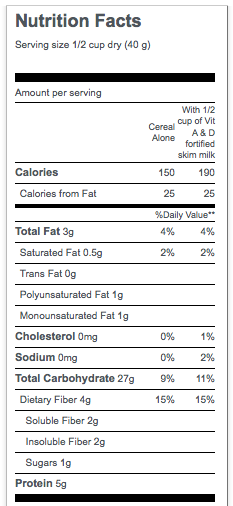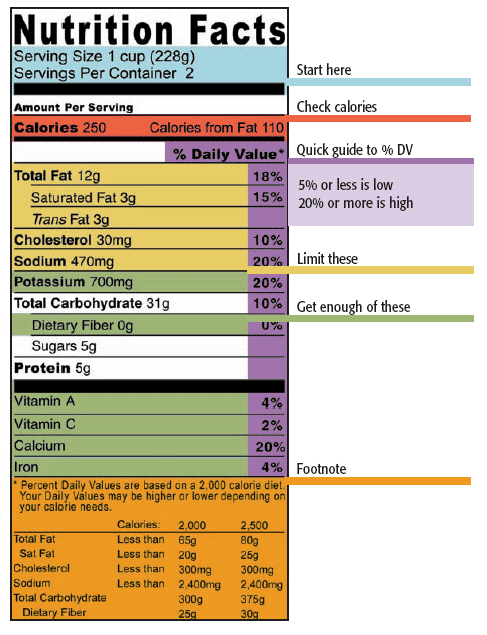 How healthy is the food item for you, really? “Low in sodium”. “Heart Healthy”. “Lots of Fiber”. Companies like to make “healthy” claims on their products to pull the consumer in. However, much of the time, their claims do not mean anything to health. Consuming their product will get the consumer no closer to a healthier lifestyle, than sitting on the couch all day long. To make sure these food products are actually healthy, the nutrition label is the first stop to finding out.
How healthy is the food item for you, really? “Low in sodium”. “Heart Healthy”. “Lots of Fiber”. Companies like to make “healthy” claims on their products to pull the consumer in. However, much of the time, their claims do not mean anything to health. Consuming their product will get the consumer no closer to a healthier lifestyle, than sitting on the couch all day long. To make sure these food products are actually healthy, the nutrition label is the first stop to finding out.
The Nutrition Label will provide accurate sums of certain macronutrients, micronutrients, and vitamins and minerals contained in the food that the body consumes on a daily basis. Such nutrients include: sodium, carbohydrates (or sugars), and fats.
Fats
It is important to understand what kinds of fat are bad and what kinds are good. Trans fats and saturated fats become solids in the bloodstream, and increase levels of low-density lipoproteins, or LDL cholesterol, which hurt your heart. Too many low-density lipoproteins leads to build-up in the arteries and the heart (CDC, 2010). Polyunsaturated fats are better for you, although still increasing LDL counts; they also increase your HDL count, which makes the heart happy. The best kind of fat the consumer should hope to see on the label is monounsaturated fat. This fat lowers LDL counts and increases HDL counts. The high-density lipoproteins, or HDL, absorb other fats and return them to the liver, which disposes of them (CDC, 2010). This type of fat, when in moderation of course, actually fights the other fats to help the heart. Make sure to limit all fat intake to only about 30% of the entire day’s food consumption, even the good fats.
Sodium
 Surprisingly, sodium (or salt) is in almost every packaged food product. “Low in Sodium” claims may trick the consumer into thinking this product will be healthier than it’s competitor; however, this claim is most often built on a sandy foundation. For example, Kikkomans all-purpose soy sauce has a whopping 309mg of sodium per teaspoon. It’s counterpart, Kikkomans less-sodium soy sauce has 192mg of sodium per teaspoon (Kikkoman, n.d.). I guarantee consumers are not just spicing up their meals with one teaspoon of soy sauce – probably a lot more. It is very important to keep the daily intake of sodium to 2,000mg a day, even better if the consumption is limited to 1,500mg a day because, although the body’s cells need some salt, sodium will bloat and strain the heart, leading to heart disease.
Surprisingly, sodium (or salt) is in almost every packaged food product. “Low in Sodium” claims may trick the consumer into thinking this product will be healthier than it’s competitor; however, this claim is most often built on a sandy foundation. For example, Kikkomans all-purpose soy sauce has a whopping 309mg of sodium per teaspoon. It’s counterpart, Kikkomans less-sodium soy sauce has 192mg of sodium per teaspoon (Kikkoman, n.d.). I guarantee consumers are not just spicing up their meals with one teaspoon of soy sauce – probably a lot more. It is very important to keep the daily intake of sodium to 2,000mg a day, even better if the consumption is limited to 1,500mg a day because, although the body’s cells need some salt, sodium will bloat and strain the heart, leading to heart disease.
Carbohydrates
Carbohydrates, or sugars, are a necessary source for the body’s energy and survival; however, not all sugars are considered good for the body. Processed and artificial sugars lead to diabetes, obesity, and heart disease over time. These kinds of sugars include: aspartame, high-fructose corn syrup, malt syrup, fruit juice concentrate, and many more.
Keep an eye out for dietary fiber, found under the carbohydrate section as well. This is very important for digestion, especially soluble fiber, which is not often found listed on the label. There are two types of fibers – soluble, which slows digestion, helps control insulin-levels/diabetes, lowers low-density lipoproteins (LDL) cholesterol levels, and makes you feel fuller longer; and insoluble, which speeds up digestion and helps prevent constipation. Try to consume around 30g of dietary fiber a day (Zelman, 2010).

Overall, take all ingredients in moderation; make sure to not leave certain nutrients and vitamins out of your diet, and keep an eye out for the extra healthy ingredients. Next time you pick up that bag of chips or a bottle of soy sauce, check the label and decide if the nutrient levels are worth it for your body.
References:
Cholesterol: LDL and HDL. (2010, February). Retrieved March 24, 2014, from Centers for Disease Control and Prevention website
[Kikkoman Soy Sauce Photograph]. (n.d.).
[Nutrition Facts Example]. (n.d.).
Nutrition Label for Quaker Oats [Illustration]. (2013, September).
Soy sauce: Less sodium, more flavor [Fact sheet]. (n.d.). Retrieved March 24, 2014, from Kikkoman USA website
Zelman, K. (2010, October). The Benefits of fiber: For your heart, weight, and energy. Retrieved March 25, 2014, from WebMD website




One response to “(Part 2 of 2) Catching Cunning Companies and Their Claims: Nutrition Label”